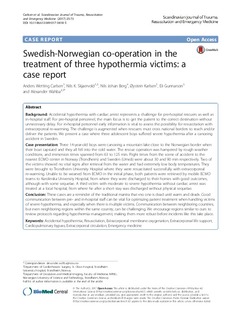| dc.contributor.author | Carlsen, Anders Wetting | |
| dc.contributor.author | Skjaervold, Nils Kristian | |
| dc.contributor.author | Berg, Nils K | |
| dc.contributor.author | Karlsen, Øystein | |
| dc.contributor.author | Gunnarsen, Eli | |
| dc.contributor.author | Wahba, Alexander | |
| dc.date.accessioned | 2017-12-14T08:12:33Z | |
| dc.date.available | 2017-12-14T08:12:33Z | |
| dc.date.created | 2017-12-12T11:12:52Z | |
| dc.date.issued | 2017 | |
| dc.identifier.citation | Scandinavian Journal of Trauma, Resuscitation and Emergency Medicine. 2017, 25 73-?. | nb_NO |
| dc.identifier.issn | 1757-7241 | |
| dc.identifier.uri | http://hdl.handle.net/11250/2471420 | |
| dc.description.abstract | Background: Accidental hypothermia with cardiac arrest represents a challenge for pre-hospital rescuers as well as in-hospital staff. For pre-hospital personnel, the main focus is to get the patient to the correct destination without unnecessary delay. For in-hospital personnel early information is vital to assess the possibility for resuscitation with extracorporeal re-warming. The challenge is augmented when rescuers must cross national borders to reach and/or deliver the patients. We present a case where three adolescent boys suffered severe hypothermia after a canoeing accident in Sweden.
Case presentation: Three 14-year-old boys were canoeing a mountain lake close to the Norwegian border when their boat capsized and they all fell into the cold water. The rescue operation was hampered by rough weather conditions, and immersion times spanned from 63 to 125 min. Flight times from the scene of accident to the nearest ECMO center in Norway (Trondheim) and Sweden (Umeå) were about 30 and 90 min respectively. Two of the victims showed no vital signs after retrieval from the water and had extremely low body temperatures. They were brought to Trondheim University Hospital where they were resuscitated successfully with extracorporeal re-warming. Unable to be weaned from ECMO in the initial phase, both patients were retrieved by mobile ECMO teams to Karolinska University Hospital, from where they were discharged to their homes with good outcomes, although with some sequelae. A third victim with moderate to severe hypothermia without cardiac arrest was treated at a local hospital, from where he after a short stay was discharged without physical sequelae.
Conclusion: These cases are a reminder of the traditional mantra that «no one is dead until warm and dead». Good communication between pre- and in-hospital staff can be vital for optimizing patient treatment when handling victims of severe hypothermia, and especially when there is multiple victims. Communication between neighboring countries, but even neighboring regions within the same country, can be challenging. We encourage regions similar to ours to review protocols regarding hypothermia management, making them more robust before incidents like this take place | nb_NO |
| dc.language.iso | eng | nb_NO |
| dc.publisher | BioMed Central | nb_NO |
| dc.rights | Navngivelse 4.0 Internasjonal | * |
| dc.rights.uri | http://creativecommons.org/licenses/by/4.0/deed.no | * |
| dc.title | Swedish-Norwegian co-operation in the treatment of three hypothermia victims: a case report | nb_NO |
| dc.type | Journal article | nb_NO |
| dc.type | Peer reviewed | nb_NO |
| dc.description.version | publishedVersion | nb_NO |
| dc.source.pagenumber | 73-? | nb_NO |
| dc.source.volume | 25 | nb_NO |
| dc.source.journal | Scandinavian Journal of Trauma, Resuscitation and Emergency Medicine | nb_NO |
| dc.identifier.doi | 10.1186/s13049-017-0418-5 | |
| dc.identifier.cristin | 1526156 | |
| dc.description.localcode | © The Author(s). 2017. Open Access. This article is distributed under the terms of the Creative Commons Attribution 4.0 International License (http://creativecommons.org/licenses/by/4.0/) | nb_NO |
| cristin.unitcode | 194,65,25,0 | |
| cristin.unitname | Institutt for sirkulasjon og bildediagnostikk | |
| cristin.ispublished | true | |
| cristin.fulltext | original | |
| cristin.qualitycode | 1 | |

